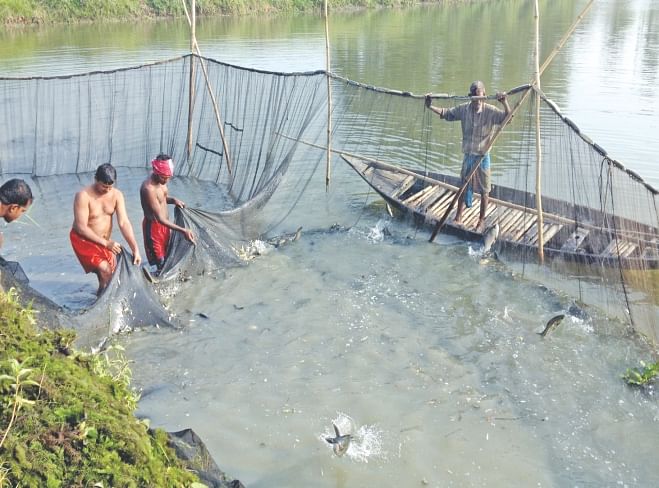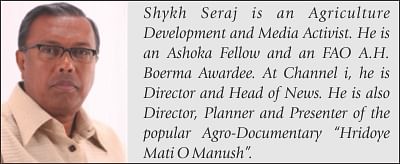Arial Beel: Home of Abundant Natural Resources
Arial Beel: Home of Abundant Natural Resources
A bountiful abode of fish that grows in the hands of nature itself

Arial Beel (Wetland) - a large water body of 136 square kilometers, situated south of Dhaka in between Padma and Dhaleshwari river. The beel's features change from season to season. Specially, during the winter time, it's diversity reaches a unique level.
A few days back, I have been there. On my way, I stopped at a local wholesale bazaar, called Shonabari in Srinagar upazila. This is a market that wraps up by 6 AM. All the fresh local fishes in the markets are sold in time. Dear readers, these fishes are local and grown in the hands of nature; not a single one is farmed, so you can guess the look, purity and taste of these fishes.
It was almost 7 AM, but heavy fog was all around and I could barely see anything. Arial beel is a huge wetland. Tens of thousands of people live on this beel's natural resources. After the monsoon is over, the region is filled with diverse fruits and crops. Famers don't use any fertilizer here because the soil is very fertile.
Md. Rafique, a famous farmer of the beel, was waiting for my arrival. Finally, I reached the Arial beel. It was very interesting conversation with the prolific farmer.
“What's the area of this small water body?”
“Six acres.”
“How many small water bodies are here in the Arial beel?”
“Numerous. There are even large water bodies which have 200 acre area.”
“What was the weightiest fish have you seen in the beel”, out of curiosity, I asked Rafique.
“A boal fish which was around 40 KGs”, replied Rafique.
“Wow!”
Nothing has changed in the Arial beel. It's been the same for the last century with its unique diversity - it has been contributing endlessly, changing the fate of millions. Arial beel is the true representation of Bangladesh where we see enrichment of fish in the water body and guarantee of crops as soon as you sow seeds.
The entire Arial beel region is filled with thick silts. Though two big rivers flow right near the beel, the rainy season's water stays on to create seasonal floods. Since the two rivers have full water flow during the monsoon, the Arial beel gets waterlogged - the water can't drain out. The difference between Chalan and Arial beel is during dry season, most lands in Chalan beel remain dry, and the lands in Arial beel remain wet all the time.
The bigger ponds of the Arial beel are known as 'denga' which are literally gold mines of local fish. Fishes live here as these are their very own home. There are many stories about the thousands of dengas in the Arial beel.
10 AM in the morning- the fog was too much. Rafique said fishermen start catching fish from early dawn, but as the fogs are here, they can't start. At 8 AM, they said they could start at 10 AM, but that seems impossible now. Not until the fogs get away, they can't catch fish. Fishermen won't come and you probably know when it's too cold, the fishes don't come up, they stay right at the bottom.
After hours of waiting, finally the fishermen are coming, said Md. Rafique. It means they're coming along with nets. These fishermen specifically catch fish with nets, a team of seven, led by Keshab Chandra.
“Since when have you been catching fish in Arial beel, Keshab?
“25 years.”
Keshab gave me some fascinating information. Only the Rui fish has five names of its own, depending on different age and size: Nola, Gorma, Holka, Rui and Srirui.
“Okay, how do you name them…I mean at what size do you call it Nola?”
“When they grow up to 1 KG, they're called Nola. When it's 2.5 KG, they're Gorma. From 2.5 to 3.5 KG, they're Holka. When they're 5.5 to 6 KG, they're called Rui.
There are as many as 2000 dengas over the Arial beel. During monsoon time, the drains are opened for the fishes to go into the Arial beel. And, we heard from the fishermen that these fishes come back to their very own dengas after they're grown in the Arial beel naturally for a year. This is the beautiful mystery of nature. We also heard that the exact number of fishes returned to their own dengas- quite surprising to me, though they claim it strongly.
These fishermen were actually binding 11 nets together to catch fish from the denga. It took at least two hours to only cast the nets.
Sixty-seven year old Mosharraf Hossain Mridha, Former Chairman of Hashara Union, Srinagar was standing right behind me. I thought it would be a good idea to learn from a wise local who has seen the beel in many ways.
“How do you see the changes in the Arial beel in these 50 years?”
Grazing of cattle was very common on open fields. Farmers used to grow Aus rice.”
“We've heard even one single koi fish (climbing perch) is sold at Tk. 1000 in this area, is this true?”
“It's true. This month, one man came and bought 80 koi fishes, paying Tk. 60,000.” I was really surprised to hear this.
Since the local fish are so precious here and sent to different parts of the country, I wanted to know how these popular and tasty fishes were transported fifty years back.
“In the past, these fishes were exported to India crossing Bagra and Bhagyakul by horses”, replied Mosharraf Mridha.
“Horses were used as transports?”, I asked.
“Yes.”
“It was impossible to carry the fishes over heads of men. That's why horses were used”, added Mosharraf.
Fishermen were wrapping up the net. They fastened eleven nets together and slowly all of formed into one large net full of fishes.
Nets came really close. I saw the fishes on the wing. Fresh and sparkling small fishes were selected from the water plantains. Chanda, Mrigel, Katla, Rui, Kalibaush, Pholi and so many other varieties of pure local fishes were netted. Do remember, these fishes are not farmed fish, they're grown in the hands of nature, eating the food provided naturally.
Dear readers, local fish are not only the resource for nutrition but also a significant aspect of our biodiversity. As the people live on the Arial beel, it's still surviving. However, the haor (wetland ecosystem) area is plagued with crisis. Farming and biodiversity in Chalan beel are also at stake. These are the key regions of the country that still protect the sanctity of natural habitats and livelihoods. If we can protect all the natural wetlands, our natural resources will stay alive, along with our fishermen, our farmers and our countrymen.
